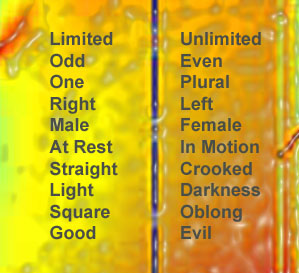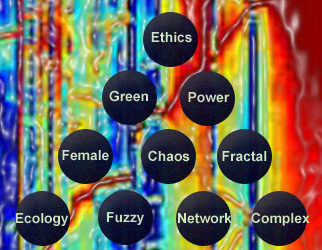Pythagorean science
by David Orrell. Based on extracts from 'The Other Side of the Coin'.
Western civilization owes a great deal to Pythagoras. Born around 570 BC, he was named after the Pythian oracle at Delphi, who had surprised his parents by announcing his imminent birth before his mother knew she was pregnant (his name literally means "the oracle speaks"). His followers later claimed that he was not completely human, but had been sired by the god Apollo, for whom the oracle was the spokesperson.
Pythagoras is credited with coining the words cosmos, and philosopher. He was involved in government and commerce, and is said to have introduced the first coinage to his region of southern Italy. His efforts kickstarted the development of mathematics, music theory, and numerical prediction. Perhaps betraying a family connection, these interests reflected those of Apollo, who was the god, among other things, of reason, music, and prophecy.
 Another of Pythagoras's many contributions to civilization was the idea of the top ten list. The Pythagoreans believed the number ten (which they called the decad) was the most complete number. They composed a list of ten opposing principles, that divided phenomena into two classes – one good, the other evil. By aligning themselves with those qualities in the left-hand column, the Pythagoreans believed they could move closer to the gods.
Another of Pythagoras's many contributions to civilization was the idea of the top ten list. The Pythagoreans believed the number ten (which they called the decad) was the most complete number. They composed a list of ten opposing principles, that divided phenomena into two classes – one good, the other evil. By aligning themselves with those qualities in the left-hand column, the Pythagoreans believed they could move closer to the gods.
The reasons why they chose these ten pairs has puzzled scholars from Aristotle on, but some can be guessed at. For example, in Pythagoras's philosophy, the universe consisted of two components: the Limited, which signified order, and the Unlimited, which represented chaos and plurality. The former was associated with the number one and odd numbers, the latter with two and even numbers. His biographer Iamblichus wrote, "The right hand he called the principle of the odd number and is divine, but the left hand is the symbol of the even number and of that which is dissolved." The right hand is controlled by the left side of the brain, which we now associate with the linear, logical reasoning championed by Pythagoras.
Like two complementary strands of DNA, this list of pairs formed the foundation of Pythagorean philosophy. The Pythagorean meme has proved extremely durable, and has spread and insinuated itself into every aspects of our lives. As the journalist and philosopher Arthur Koestler wrote of Pythagoras, "his influence on the ideas, and thereby on the destiny, of the human race was probably greater than that of any single man before or after him." (The influence has not been universally perceived as positive – the biologist Robert Rosen, for example, associates Pythagoras with "a disastrous turn" whose impact "has spread far beyond mathematics.")
In the so-called "hard" sciences, such as mathematical physics, the Pythagorean approach was tremendously successful, and led to the discovery of fundamental principles that seemed to govern nature. Isaac Newton showed that the movement of physical objects, from apples to the moon, all obeyed simple mathematical relationships (he believed that his law of gravity had been known by Pythagoras, and he had only rediscovered it). And in the 1870s, neoclassical economists modelled their theory on the "rational mechanics" of Newton. At that moment the Pythagorean meme jumped the barrier from physics to economics.
In a very real sense, we are all Pythagoreans. We are all the children of Apollo. We carry around with us a set of ideas that is two and a half thousand years old. But slowly, those ideas are being turned on their head.
Post-Pythagorean Science

Since the 1960s, new sciences have emerged that directly challenge the Pythagorean Good/Evil divide.
Limited/Unlimited: Ecology dates back to the 1860s, but it was only in the 1960s that scientists like Eugene Odum and Kenneth Boulding started to see the human race as part of the world eco-system. It deals in natural systems in which natural resources are recycled, so are both limited (they are finite) and unlimited (they never run out).
Odd/Even: The Pythagoreans associated the even numbers with the number 2, which signified duality and uncertainty. Fuzzy logic provides a way of dealing with statements that are partially true and partially false – that are inherently dualistic.
One/Plurality: Network theory is about the properties of systems that arise from interactions between individual members.
Right/Left: The right hand is controlled by the left side of the brain, which specialises in abstract, reductionist thought. Complexity theory is about emergent properties which elude such reductionist analysis.
Male/Female: Science has traditionally been a male-dominated activity. Feminist science is changing the kinds of questions that scientists ask about nature.
At Rest/In Motion: Nonlinear dynamics and chaos deals with systems that are not at equilibrium.
Straight/Crooked: Fractals is a science of crooked lines.
Light/Darkness: Science and progress have always aimed to illuminate nature. Green technologists argue that maybe we should turn down the lights.
Square/Oblong: Power-law theory deals with the asymmetries that naturally arise in complex systems.
Good/Evil: Science is neither inherently good nor inherently evil. As science grows in power and sophistication, scientific ethics become increasingly important.
